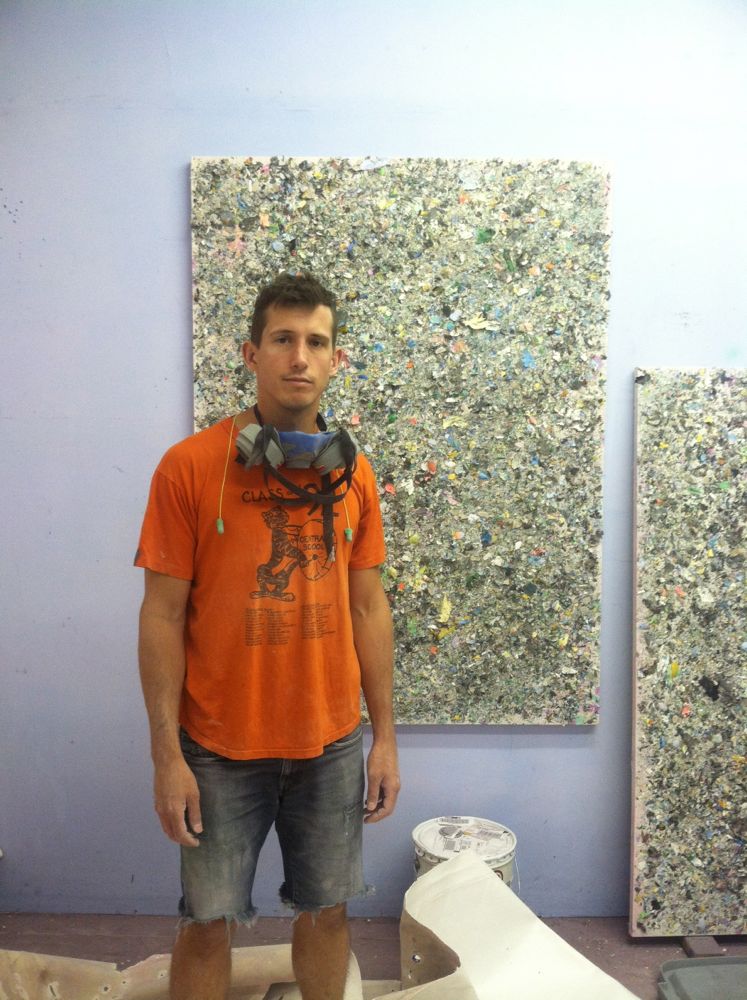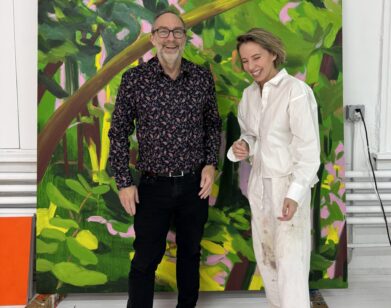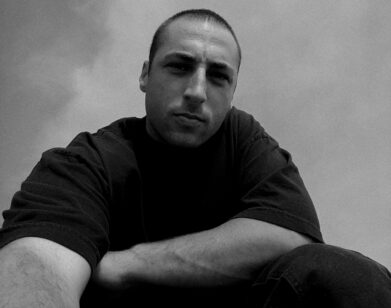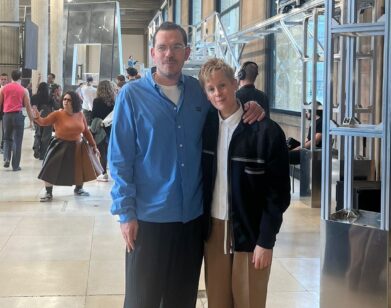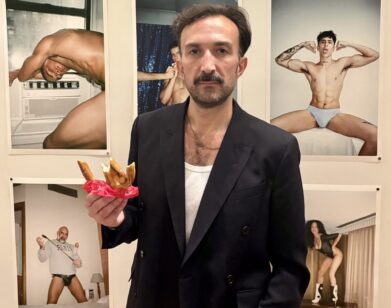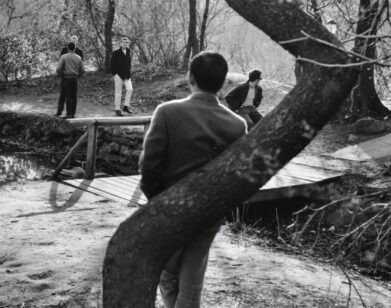Dungeons, Dragons, and Art
Kadar Brock is breaking down the romantic (and Romantic) notions concerning what it means to be an artist. Once a starry-eyed believer in the idea of the artist as an “autonomous genius,” Brock’s most recent body of work relies instead on ritualistic practice. His paintings are systematically destroyed through a process of sanding and re-sanding and perhaps re-sanding once again until they are tattered and worn, bleak and beautiful. It is a process based loosely on the fantasy game Dungeons and Dragons.
Brock’s current exhibition at New York’s The Hole, titled “Dredge,” features a series of these shredded canvases, hung sparsely throughout the space. Together they are the result of hours of labor-intensive art making, proof that, although Brock aims to “demystify” the artist, the works are still very much a product of his hands.
The exhibit is complemented by the work of Kasper Sonne, another artist whose pieces exemplify the beauty of destruction, in his case by setting his works on fire. “The starting point is my interest in exploring dichotomies,” explains Sonne. “The paintings are painted using a roller instead of a brush to make a perfect monochrome painting. Then they’re set on fire. Control is contrasted by chance. Perfect by imperfect.” It is a dichotomy evident in both Sonne and Brock’s work. Destruction can rarely, if ever, be controlled.
We caught up with Brock on plush beanbag chairs at The Hole to chat about the exhibition, ritualizing art and, of course, Dungeons and Dragons.
ALLYSON SHIFFMAN: At what point did you know you wanted to pursue art professionally?
KADAR BROCK: I think I was 10 years old. I used to make cartoons and comic books with friends. My dad had a book of Picasso paintings in his apartment and he said, “Look at these!” I was like, “Oh, these are really cool.” And he goes, “Yeah, these are millions of dollars!” I said, “You can do that? That sounds great! I want to do that.”
SHIFFMAN: [laughs] It was a moneymaking vocation?
BROCK: It was more like, oh, I can do that and be rich? That seems great. Instead of drawing comic books, which is a functional application of art, if I’m totally self-indulgent and just make whatever I want to make and talk about whatever I want to talk about, people will actually pay me to do that? [laughs] I can do that?
SHIFFMAN: How did your parents react?
BROCK: My parents split up when I was really young. My dad was the “weekend dad” who was always really supportive, and my mom was the practical mom who was trying to discipline me.
SHIFFMAN: What’s the point of your art-making?
BROCK: [laughs] There are a couple points. One is that I don’t know what the fuck else I’d do with myself. I have all this time, and I figured I’d fill up that time by making paintings. In a larger context, it makes me happy and hopefully it makes other people happy. It sets up a situation where I can talk to people and share life experience and share ideas. More specifically, it’s about talking about belief structures in painting and in abstraction and using that to talk about larger emotional and psychological life phenomena… [laughs] Maybe.
SHIFFMAN: [laughs] How did this particular series come about?
BROCK: This body of work is something I’ve been working on since 2010. Essentially, these works are made by taking older paintings that are these gestural, grand abstractions and putting them through a series of rituals to deconstruct and physically destroy gestures in the painting.
SHIFFMAN: Can you break down the “series of rituals?”
BROCK: The first thing is taking said old painting off the stretcher bars and putting it on a floor or on a table and going at it with a razor blade, the same way I would go at cleaning a palette. Then I start power sanding it to take off more information. Then I start priming it with an industrial primer. After doing that and sanding it one or two or three times, I’ll start reintroducing color back into the piece and then repeating the process cyclically until it gets to a place where I feel okay about it.
SHIFFMAN: I have read that the titles of your pieces come from Dungeons and Dragons. Can you elaborate on that, keeping in mind I know absolutely nothing about Dungeons and Dragons?
BROCK: The larger trajectory was this interest in wanting to deconstruct gesture and my beliefs about abstraction. Much of that belief structure was coming from early Romanticism. Romantics believed every artistic action was an expression of the artist’s true character and intention. I realized that was kind of a faulty stage to stand on in regard to making paintings, so I wanted to figure out a way to fuck with that line of thinking. I started making paintings that were minimal, geometric diamond patterns. Then I distilled that into one zigzag mark and repeating it four ways. It was about making that mark, which is so basic and so off-the-cuff and so bullshit. As a way to push further away from my gesture and this idea of autonomous artistic genius, I started using an avatar that was mocked up from Dungeons and Dragons. I used this avatar to get statistical information and then I would use the rules as they applied to specific spells from the game to set up external parameters.
SHIFFMAN: How does that work?
BROCK: I would role a six-sided die three times to figure out how many marks would be in each column and then add that to the statistical modifiers of the avatar and that would be the painting. Part of it was wanting to remove the gestures from me.
SHIFFMAN: So it would be left up to chance rather than an indication of your “character”?
BROCK: Exactly. It was also the idea of the artist as a wizard or shaman. I’m a total nerd—I love magic things. By hashing out that player’s attributes in addition to casting the spells—which is rolling the dice and making these marks—I wanted to perform rituals. Part of being a wizard in Dungeons and Dragons is performing rituals…
SHIFFMAN: I’m getting a real D&D education right now.
BROCK: [laughs] Part of it is this childhood fantasy fulfillment. I never got to play it when I was a kid because I didn’t have friends that were into that shit. The closest I got was my aunt playing one half-hour game with me… Which is terrible.
SHIFFMAN: So go on. What about rituals?
BROCK: To perform rituals, you need certain materials, and the universal material is “the residue of disenchanted magical items.” So if my old beliefs about paintings are true, then they are magical items. And if I disenchant them and pull everything off of them, that can be the stuff I can go perform rituals with. So these [destroyed paintings] are the disenchanted magical items, and those [paintings made from the residual materials] are the rituals. But the whole idea of disenchanting a magical item is a ritual unto itself…. [laughs]
SHIFFMAN: [laughs] So the titles…
BROCK: So, to get back to the titles. All these titles are super weird gobbledygook, long strings of letters, but they all contain the letters D, E, M, I, which abbreviates “Disenchanted Magical Item,” and then R, E is “Re-enchant,” which signifies me adding layers of color back into it. The repetition of that is disenchant, re-enchant, disenchant, re-enchant and the set of initials after that is usually a reference to whatever the initial painting was. This one was called Shadow Clone at one point, so it ends with “S.C.” That was a long-winded explanation.
SHIFFMAN: You’re a nerd, basically.
BROCK: In some ways, yeah. But I think all that shit has a lot of ramifications and metaphoric extensions into all aspects of making paintings and to the way we relate to paintings. That’s why I adopted this system; it’s an interesting way to look at this relationship to abstraction.
SHIFFMAN: Do you think about who purchases your paintings?
BROCK: I try not to. One side of that is fascinating in that they become collaborative just in how they end up existing in a space beyond one I’ve approved of. I had a piece in a show in Hong Kong that went to some collector out there. She had crazy bright pink walls, and it was a piece that had an orangey-pinkish palette. She interacted with my work and changed it in a way. That’s cool. As far as other stuff… You have no idea where the people that buy your work are coming from politically, ethically, emotionally… so that’s the stuff I try not to think about. I like to imagine we’re all simpatico and that’s why they’re into it, but the reality of the situation is that’s not usually the case.
SHIFFMAN: That’s a nice thought.
BROCK: I went by a friend’s studio and he was saying, “I like to think whoever is buying my work is someone who wishes they were an artist but they’re not, so they want to support my creative impulses.” It’s this dreamy idea of a patron.
SHIFFMAN: [laughs] A mystery benefactor who buys up your work through other dealers so it doesn’t look suspicious.
BROCK: [laughs] That’s even better! That would be awesome.
SHIFFMAN: If you could go back in time and give yourself a piece of advice when you were first starting out, what would it be?
BROCK: To take more people’s classes when I was in college [at Cooper Union].
SHIFFMAN: [laughs] Actually?
BROCK: Seriously! Tying it back into this Romantic idea of what being an artist is, when I was in college I was so set on this idea of finding a mentor.
SHIFFMAN: I’ve tried to do that. People generally don’t want that responsibility.
BROCK: It doesn’t exist! I totally wanted that so I kept taking the same people’s classes and really trying to foster those relationships. All my friends got to meet all these other artists, whose work I really like, but because I was so in this alternate mentality I never got a chance to meet them. So it would be: Get that bullshit out of your head and go take more classes. There’s no such thing as a mentor.
SHIFFMAN: Do you have post-opening depression right now?
BROCK: Maybe. I was feeling a little bummed out today. I went to my studio and I was trying to do some stuff and all I had around to do was sweep and clean. Then I pulled out this one thing I tried out a couple months ago that was a total failure and was taking that apart. All I had was this failed piece of shit.
SHIFFMAN: What does your studio look like?
BROCK: Right now it looks empty… And a little less dusty.
“DREDGE” IS ON SHOW AT THE HOLE IN NEW YORK THROUGH OCTOBER 10. FOR MORE INFORMATION, VISIT THE GALLERY’S WEBSITE.

